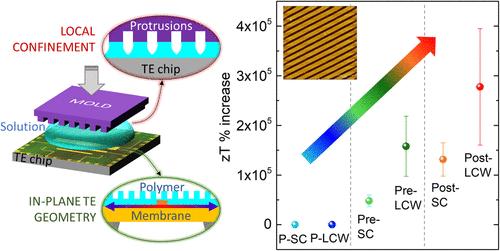Our official English website, www.x-mol.net, welcomes your
feedback! (Note: you will need to create a separate account there.)
Enhancing zT in Organic Thermoelectric Materials through Nanoscale Local Control Crystallization
ACS Nano ( IF 15.8 ) Pub Date : 2024-11-16 , DOI: 10.1021/acsnano.4c10801 Gabriele Calabrese, Raimondo Cecchini, Denis Gentili, Diego Marini, Matteo Ferri, Fulvio Mancarella, Luisa Barba, Massimiliano Cavallini, Vittorio Morandi, Fabiola Liscio
ACS Nano ( IF 15.8 ) Pub Date : 2024-11-16 , DOI: 10.1021/acsnano.4c10801 Gabriele Calabrese, Raimondo Cecchini, Denis Gentili, Diego Marini, Matteo Ferri, Fulvio Mancarella, Luisa Barba, Massimiliano Cavallini, Vittorio Morandi, Fabiola Liscio

|
Organic thermoelectric materials are promising for wearable heating and cooling devices, as well as near-room-temperature energy generation, due to their nontoxicity, abundance, low cost, and flexibility. However, their primary challenge preventing widespread use is their reduced figure of merit (zT) caused by low electrical conductivity. This study presents a method to enhance the thermoelectric performance of solution-processable organic materials through confined crystallization using the lithographically controlled wetting (LCW) technique. Using PEDOT as a benchmark, we demonstrate that controlled crystallization at the nanoscale improves electrical conductivity by optimizing chain packing and grain morphology. Structural characterizations reveal the formation of a highly compact PEDOT arrangement, achieved through a combination of confined crystallization and DMSO post-treatment, leading to a 4-fold increase in the power factor compared to spin-coated films. This approach also reduces the thermal conductivity dependence on electrical conductivity, improving the zT by up to 260%. The LCW technique, compatible with large-area and flexible substrates, offers a simple, green, and low-cost method to boost the performance of organic thermoelectrics, advancing the potential for sustainable energy solutions and advanced organic electronic devices.
中文翻译:

通过纳米级局部控制结晶增强有机热电材料中的 zT
有机热电材料因其无毒、丰富、低成本和柔韧性而有望用于可穿戴加热和冷却设备以及接近室温的能源生产。然而,它们阻碍广泛使用的主要挑战是由于低导电性导致品质因数 (zT) 降低。本研究提出了一种通过使用光刻控制润湿 (LCW) 技术进行限制结晶来提高可溶液加工有机材料的热电性能的方法。以 PEDOT 为基准,我们证明了纳米级的受控结晶通过优化链堆积和晶粒形态来提高导电性。结构表征揭示了通过限制结晶和 DMSO 后处理相结合实现的高度紧凑的 PEDOT 排列的形成,与旋涂薄膜相比,功率因数增加了 4 倍。这种方法还减少了导热系数对导电性的依赖性,将 zT 提高了 260%。LCW 技术与大面积和柔性基板兼容,提供了一种简单、绿色和低成本的方法来提高有机热电技术的性能,推动了可持续能源解决方案和先进有机电子器件的潜力。
更新日期:2024-11-16
中文翻译:

通过纳米级局部控制结晶增强有机热电材料中的 zT
有机热电材料因其无毒、丰富、低成本和柔韧性而有望用于可穿戴加热和冷却设备以及接近室温的能源生产。然而,它们阻碍广泛使用的主要挑战是由于低导电性导致品质因数 (zT) 降低。本研究提出了一种通过使用光刻控制润湿 (LCW) 技术进行限制结晶来提高可溶液加工有机材料的热电性能的方法。以 PEDOT 为基准,我们证明了纳米级的受控结晶通过优化链堆积和晶粒形态来提高导电性。结构表征揭示了通过限制结晶和 DMSO 后处理相结合实现的高度紧凑的 PEDOT 排列的形成,与旋涂薄膜相比,功率因数增加了 4 倍。这种方法还减少了导热系数对导电性的依赖性,将 zT 提高了 260%。LCW 技术与大面积和柔性基板兼容,提供了一种简单、绿色和低成本的方法来提高有机热电技术的性能,推动了可持续能源解决方案和先进有机电子器件的潜力。


















































 京公网安备 11010802027423号
京公网安备 11010802027423号